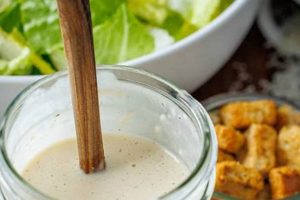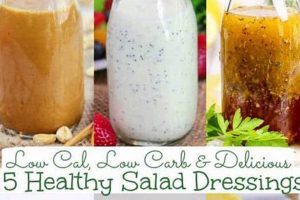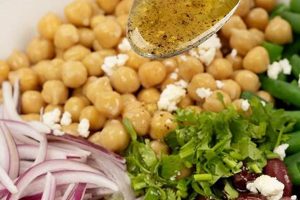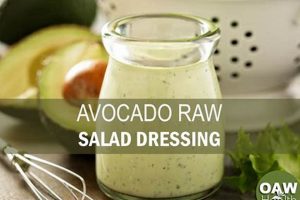Dressings without added sugars offer a flavorful way to enhance salads while adhering to dietary restrictions or preferences. These recipes typically utilize ingredients like herbs, spices, vinegars, citrus juices, and healthy fats to create delicious, low- or no-sugar alternatives to conventional dressings often laden with added sugars. For example, a simple vinaigrette can be made with olive oil, apple cider vinegar, Dijon mustard, and fresh herbs.
Reducing sugar intake is often associated with improved metabolic health and weight management. By eliminating added sugars from salad dressings, individuals can control their overall sugar consumption and potentially mitigate associated health risks. Historically, salads were dressed simply with oil and vinegar or lemon juice. The introduction of bottled dressings with added sugars is a relatively recent phenomenon. The growing awareness of the health implications of excess sugar consumption has fueled the demand for healthier options, leading to an increase in recipes and commercially available no-sugar-added dressings.
This article will explore various approaches to crafting flavorful dressings without added sugar, covering topics such as ingredient selection, flavor balancing techniques, and creative recipe ideas to inspire culinary experimentation in the kitchen.
Tips for Creating Delicious Sugar-Free Salad Dressings
Crafting flavorful salad dressings without added sugar requires careful consideration of ingredient choices and flavor balancing techniques. The following tips offer guidance for creating dressings that are both healthy and delicious.
Tip 1: Embrace the Acidity of Vinegar. Vinegar provides a foundational tartness that balances the richness of oils and other ingredients. Experiment with different varieties, such as apple cider vinegar, red wine vinegar, balsamic vinegar, or white wine vinegar, each offering unique flavor profiles.
Tip 2: Explore Citrus Juices. Freshly squeezed lemon, lime, or orange juice adds brightness and complexity to dressings. These juices can be used alone or in combination with vinegar for a layered flavor profile.
Tip 3: Utilize Fresh Herbs and Spices. Fresh herbs, such as parsley, dill, mint, or chives, and spices, such as garlic powder, onion powder, or paprika, offer potent flavor enhancements without added sugar.
Tip 4: Incorporate Healthy Fats. Extra virgin olive oil, avocado oil, or flaxseed oil provide a rich base for dressings and contribute to satiety. The quality of the oil significantly impacts the overall flavor.
Tip 5: Enhance with Umami. Ingredients like nutritional yeast, Dijon mustard, or a small amount of grated Parmesan cheese can add a savory depth of flavor, balancing the acidity and sweetness from other components.
Tip 6: Balance Sweetness with Sugar Alternatives. If sweetness is desired, consider using a small amount of a sugar alternative such as stevia or erythritol. Exercise caution and taste as you go, as these can sometimes have a slightly different flavor profile.
Tip 7: Emulsify for Texture. A proper emulsion creates a creamy and cohesive dressing. Use a whisk or blender to combine the ingredients thoroughly, ensuring they are well incorporated.
By following these tips, flavorful and healthy sugar-free salad dressings can be easily created, enhancing the nutritional value and enjoyment of any salad.
The following section will provide specific recipe examples to demonstrate these principles in practice.
1. Health-conscious choices
Health-conscious choices play a crucial role in the creation of sugar-free salad dressings, impacting both flavor and nutritional value. These choices reflect a broader dietary awareness, prioritizing ingredient quality and minimizing processed components often found in conventional dressings.
- Ingredient Selection
Opting for fresh, whole ingredients forms the foundation of health-conscious dressing preparation. This includes selecting high-quality oils (e.g., extra virgin olive oil, avocado oil), fresh herbs and spices, and natural sources of acidity like vinegars and citrus juices. Avoiding processed oils, artificial flavors, and added sugars ensures the dressing contributes positively to overall dietary intake.
- Sugar Alternatives
Health-conscious individuals often seek alternatives to refined sugars. In salad dressings, this translates to utilizing natural sweeteners like small amounts of fruit purees, dates, or sugar alternatives like stevia or erythritol. Careful consideration of flavor profiles and potential impacts on blood sugar levels is essential when incorporating these alternatives.
- Portion Control
Even with healthy ingredients, portion control remains a key aspect of health-conscious eating. While sugar-free dressings offer a healthier alternative, excessive consumption of fats, even healthy fats, can contribute to caloric surplus. Mindful portioning ensures that the dressing complements the salad’s nutritional benefits without undermining overall dietary goals.
- Homemade vs. Store-Bought
Making dressings at home allows for complete control over ingredients, aligning with health-conscious preferences. However, carefully examining labels of store-bought options can identify suitable sugar-free alternatives. Prioritizing dressings with minimal ingredients and recognizable components ensures alignment with health-conscious principles.
These facets of health-conscious decision-making demonstrate a commitment to overall well-being, extending beyond simply eliminating sugar. By embracing these principles, individuals can create sugar-free salad dressings that are both flavorful and contribute positively to a balanced, nutritious diet.
2. Natural Sweeteners
Natural sweeteners offer a crucial bridge between flavor and health in sugar-free salad dressing recipes. They provide the desired touch of sweetness without the negative health implications associated with refined sugars. This connection is essential for creating palatable dressings that align with dietary restrictions or health-conscious choices. For example, a small amount of date paste can lend a subtle sweetness and caramel-like complexity to a balsamic vinaigrette, while a touch of pureed apple or pear can brighten a citrus-based dressing. Understanding the role of natural sweeteners empowers individuals to create dressings that satisfy taste preferences while maintaining nutritional integrity.
The careful selection and application of natural sweeteners contributes significantly to the overall balance and complexity of sugar-free dressings. While these sweeteners offer a healthier alternative, their impact on flavor can vary significantly. Dates, for instance, provide a robust, almost molasses-like sweetness, while fruit purees offer a lighter, brighter sweetness. Overuse can lead to an overly sweet dressing, masking the other delicate flavors. Strategic incorporation, often in small quantities, allows the natural sweetness to enhance the other ingredients, creating a harmonious flavor profile. A balsamic vinaigrette, for example, might benefit from a touch of date paste to balance the acidity, while a raspberry vinaigrette might use a small amount of pureed raspberries to intensify the berry flavor. This nuanced approach distinguishes a well-crafted dressing from one that simply substitutes sugar with an alternative sweetener.
Successful integration of natural sweeteners hinges on understanding their individual characteristics and how they interact with other dressing components. Balancing sweetness with acidity, saltiness, and the flavors of herbs and spices creates a complex and satisfying taste experience. Experimentation is key to achieving the desired balance, as the optimal amount of sweetener can vary depending on the other ingredients. Recognizing this interplay of flavors elevates sugar-free salad dressings from simple substitutes to culinary creations in their own right.
3. Flavorful Ingredients
Flavorful ingredients are essential to crafting compelling sugar-free salad dressings. The absence of added sugar necessitates a heightened focus on other flavor components to achieve a balanced and satisfying taste profile. This connection hinges on understanding how various ingredients interact and contribute to the overall sensory experience. For instance, the sharpness of Dijon mustard can be balanced by the richness of olive oil and the brightness of lemon juice, creating a complex flavor profile without relying on sweetness. Similarly, the earthiness of dried herbs like oregano or thyme can add depth to a vinaigrette, while the freshness of chopped cilantro or mint can provide a vibrant counterpoint.
Strategic combination of herbs, spices, acids, and fats forms the backbone of flavorful sugar-free dressings. Acidity, often derived from vinegar or citrus juice, provides a necessary counterpoint to the richness of fats. The specific type of acid contributes unique flavor nuances; apple cider vinegar offers a mild sweetness, while red wine vinegar provides a more robust tang. Herbs and spices introduce aromatic complexity and depth. Fresh herbs offer vibrant, nuanced flavors, while dried herbs provide a more concentrated, earthy taste. Careful consideration of these elements allows for the creation of dressings that are both flavorful and complex, without reliance on added sugars. A dressing featuring roasted red peppers, for example, might benefit from the smoky depth of smoked paprika and the nuttiness of toasted sesame oil, while a lighter, citrus-based dressing might be enhanced by the bright, peppery flavor of fresh ginger and the fragrant aroma of lemongrass.
Ultimately, the success of a sugar-free salad dressing lies in the thoughtful selection and harmonious balance of flavorful ingredients. This approach necessitates a shift in perspective, moving away from the reliance on sugar as a primary flavor component and embracing the potential of other ingredients. The resulting dressings not only cater to specific dietary needs but also offer a nuanced and satisfying culinary experience that celebrates the inherent flavors of fresh, whole foods. This understanding allows for the creation of dressings that are both flavorful and aligned with health-conscious principles, showcasing the potential of sugar-free cuisine to be both delicious and nutritious.
4. Versatile Recipes
Versatility in sugar-free salad dressing recipes significantly expands their utility and appeal. Adaptability to various cuisines, ingredients, and dietary preferences enhances the practical application of these recipes. A basic vinaigrette, for example, can be transformed with the addition of different herbs, spices, or citrus fruits, allowing it to complement diverse salads ranging from Mediterranean to Asian-inspired. This adaptability is crucial for individuals seeking to reduce sugar intake without sacrificing flavor or variety in their meals. Furthermore, versatile recipes can accommodate seasonal ingredients, promoting both culinary creativity and the consumption of fresh, locally sourced produce. A simple lemon-herb dressing, for instance, can be adapted to utilize seasonal herbs like basil in the summer and rosemary in the winter, ensuring year-round enjoyment.
The inherent adaptability of sugar-free dressings stems from their reliance on core flavor principles rather than fixed ingredient lists. Balancing acidity, fat, and aromatics provides a foundational framework upon which numerous variations can be built. This framework allows for substitutions based on individual preferences or dietary restrictions. Olive oil can be replaced with avocado oil, apple cider vinegar with lemon juice, and dried herbs with fresh ones, all while maintaining the fundamental balance of flavors. This flexibility empowers individuals to personalize recipes, fostering a sense of ownership and culinary exploration. Moreover, versatile recipes encourage experimentation with flavor profiles, expanding culinary horizons beyond the limitations of traditional sugar-laden dressings. A simple balsamic vinaigrette can be transformed with the addition of Dijon mustard, grated ginger, or even a touch of smoked paprika, creating unique and exciting flavor combinations.
Versatility in sugar-free salad dressing recipes represents a crucial element in their successful integration into a wider culinary context. This adaptability facilitates both adherence to dietary guidelines and the enjoyment of flavorful, diverse meals. By understanding the underlying principles of flavor balance and ingredient substitution, individuals can create customized dressings that cater to their specific needs and preferences, ultimately promoting a sustainable and enjoyable approach to healthy eating. This mastery of versatile recipes empowers individuals to move beyond pre-packaged options and embrace the creative potential of sugar-free cuisine.
5. Easy Preparation
Ease of preparation plays a significant role in the adoption and consistent use of sugar-free salad dressing recipes. Simplicity and convenience are key factors influencing dietary choices, especially when aiming to replace less healthy alternatives. The accessibility of these recipes directly impacts their practicality and sustainability within a broader dietary framework.
- Minimal Ingredients and Equipment
Sugar-free salad dressings often require fewer ingredients than their conventional counterparts, eliminating the need for processed sugars and artificial additives. This streamlined approach simplifies the shopping list and reduces preparation time. Furthermore, most recipes utilize common kitchen tools like whisks, bowls, and measuring spoons, eliminating the need for specialized equipment. A simple vinaigrette, for example, requires only oil, vinegar, and seasonings, all easily combined in a jar or bowl.
- Quick Assembly
The majority of sugar-free salad dressings can be assembled in a matter of minutes. This rapid preparation contrasts sharply with the time investment often associated with more complex culinary endeavors. The speed and efficiency of creating these dressings contribute to their appeal for busy individuals seeking healthy, convenient meal options. A basic lemon-herb dressing, for instance, can be whisked together in under five minutes.
- Adaptability and Make-Ahead Options
Many sugar-free dressings can be prepared in advance and stored for later use, further enhancing their convenience. This make-ahead option allows for efficient meal preparation, ensuring that a healthy dressing is readily available even during time-constrained situations. Vinaigrettes, in particular, store well in the refrigerator for several days, allowing for batch preparation and reduced daily effort.
- Simplified Flavor Balancing
While flavor balancing is crucial in any culinary creation, sugar-free dressings often involve a more straightforward approach. The absence of added sugar simplifies the flavor profile, allowing for a clearer focus on the balance between acidity, fat, and aromatics. This simplified approach facilitates recipe adaptation and experimentation, empowering individuals to adjust flavors to their liking without complex calculations or measurements.
The ease of preparation associated with sugar-free salad dressing recipes contributes significantly to their practicality and long-term integration into a health-conscious lifestyle. This simplicity, combined with the use of fresh, whole ingredients, positions these recipes as a convenient and accessible alternative to commercially produced dressings often laden with added sugars and unhealthy additives. This accessibility empowers individuals to make healthier choices without sacrificing flavor or convenience, fostering a sustainable approach to dietary improvement. The ease of creating these dressings encourages consistent use, further reinforcing healthy eating habits.
6. Dietary needs
Dietary needs often necessitate careful consideration of added sugars, making sugar-free salad dressing recipes a valuable resource. Conditions such as diabetes, insulin resistance, or weight management goals frequently require limitations on sugar intake. Sugar-free dressings offer a viable solution, allowing individuals to enjoy flavorful salads without compromising their dietary restrictions. For example, a person managing diabetes can use a sugar-free vinaigrette made with olive oil, vinegar, and herbs to add flavor to a salad without impacting blood glucose levels significantly. Similarly, someone aiming for weight loss can benefit from reduced caloric intake associated with eliminating added sugars from dressings. This connection highlights the practical significance of sugar-free recipes in accommodating specific dietary requirements.
Beyond specific medical conditions, broader health-conscious trends also drive the demand for sugar-free options. Increasing awareness of the potential negative impacts of excessive sugar consumption motivates many individuals to reduce their overall sugar intake. Sugar-free salad dressings provide a practical means to achieve this goal, allowing individuals to make healthier choices without sacrificing taste or enjoyment. This broader application expands the relevance of sugar-free recipes beyond specific dietary restrictions and positions them as a valuable tool for promoting overall well-being. For instance, someone following a low-carbohydrate diet might choose a sugar-free creamy dressing made with avocado and lime juice, while another individual might simply prefer to limit added sugars for general health maintenance. This versatility demonstrates the adaptability of sugar-free dressings to diverse dietary preferences.
Understanding the link between dietary needs and sugar-free salad dressing recipes underscores the importance of ingredient awareness and recipe adaptation. Successfully addressing specific dietary requirements often necessitates careful scrutiny of ingredient lists and creative substitution. This empowers individuals to take control of their nutritional intake and make informed choices that align with their health goals. While sugar-free recipes provide a valuable starting point, individual needs may require further modifications, such as reducing sodium content or adapting to specific allergies or intolerances. This recognition of individual variability within the context of dietary needs emphasizes the importance of personalized approaches to healthy eating. Ultimately, sugar-free salad dressings provide a flexible and adaptable foundation for creating meals that are both flavorful and supportive of diverse dietary requirements.
Frequently Asked Questions
This section addresses common inquiries regarding sugar-free salad dressing recipes, providing concise and informative responses.
Question 1: Are all sugar-free salad dressings low in calories?
Not necessarily. While eliminating added sugar reduces calories, the fat content in oil-based dressings can still contribute significant calories. Portion control remains important even with sugar-free options.
Question 2: Can sugar-free dressings be used for other culinary applications?
Absolutely. Sugar-free dressings can serve as marinades for meat or vegetables, dips for crudits, or flavorful additions to sandwiches and wraps.
Question 3: How can one ensure a sugar-free dressing emulsifies properly?
Thorough whisking or blending is essential. An immersion blender or a traditional blender can create a stable emulsion. Adding a small amount of Dijon mustard can also help stabilize the mixture.
Question 4: What are the best storage practices for homemade sugar-free dressings?
Store dressings in airtight containers in the refrigerator. Most sugar-free dressings, especially vinaigrettes, will last for several days, allowing for convenient make-ahead preparation.
Question 5: Are there commercially available sugar-free dressings that align with health-conscious principles?
Yes, but careful label reading is essential. Look for dressings with minimal ingredients, avoiding artificial sweeteners, preservatives, and excessive amounts of unhealthy fats.
Question 6: How can one adjust the sweetness of a sugar-free dressing without adding sugar?
Natural sweeteners like a small amount of date paste, fruit puree, or a sugar alternative like stevia can be used judiciously. Taste and adjust incrementally to achieve the desired level of sweetness.
Careful consideration of ingredients and mindful preparation techniques are crucial for creating flavorful and healthy sugar-free salad dressings.
The following section will provide concluding remarks and summarize key takeaways regarding the creation and benefits of sugar-free salad dressings.
Conclusion
Exploration of sugar-free salad dressing recipes reveals the potential for flavorful and health-conscious culinary creations. Emphasis on fresh, whole ingredients, coupled with strategic use of natural sweeteners and flavor-balancing techniques, allows for the development of dressings that cater to a variety of dietary needs and preferences. The ease of preparation and adaptability of these recipes further enhances their practical application, encouraging consistent integration into healthy eating patterns. From simple vinaigrettes to more complex emulsified dressings, the possibilities within the realm of sugar-free options are vast and readily accessible.
Shifting away from reliance on added sugars in salad dressings represents a significant step towards mindful eating and improved dietary health. Exploration of these recipes empowers individuals to take control of their nutritional intake and discover the inherent flavors of natural ingredients. This culinary shift promotes not only individual well-being but also a broader appreciation for the connection between food and health. The ongoing development of innovative sugar-free options promises a future where flavorful and health-conscious choices are readily available and easily integrated into everyday life.






